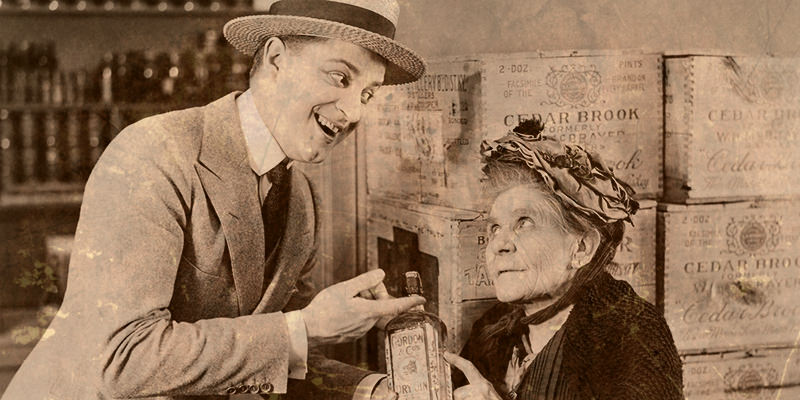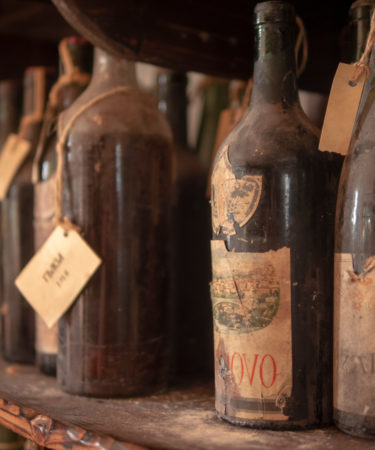

Assuming you’re lucky enough to have one or both grandparents around, and assuming you head over the river, through the woods, and make it through baggage claim to get to them this Thanksgiving, there’s a chance you’ll be rewarded with an array of unknown spoils. By which we mean the contents of grandma’s, or grandpa’s, liquor cabinet.
We’re not recommending you sneak away from Thanksgiving dinner to go raid the contents of Nana’s bar cart or Pop Pop’s “secret” drawer. But if your grandparents are cool with it—and there’s a good chance they haven’t looked in their liquor cabinet in a few years—you might just have some fun poking around the old dusty bottles to see what you can find.
Bear in mind, this isn’t necessarily going to yield anything drinkable, so don’t grab a glass and start tearing through old corks and tax stamps*. Anything that’s been opened for more than a couple years and isn’t high-proof (40%ABV) should be thrown away. Or left alone, for grandma to reminisce about, but just not poured into a tumbler and thrown back with groggy tryptophan abandon. Plus, it’s Thanksgiving. We’re assuming there’s plenty of fresher bottles on hand.
We’re also not recommending you raid grandma’s liquor cabinet with some sense of financial gain. Yes, there is such a thing as “dusty hunting”—basically the store-to-store search for old bottles that may be of some value. But that’s more of a collectors game, and then there’s the pesky fact that it’s illegal to sell alcohol without a license.
So you probably can’t drink it, and technically can’t sell it (we’ll just look the other way here…). What’s the point? Honestly, fascination, maybe some nostalgia (get your grandma to start talking about that old bottle of Gordon’s vodka), and maybe—if you’re very lucky—a literal taste of history.
What you’re going to find will vary, of course, depending first on your age (and the respective generational gaps between your parents and theirs) and second on your grandparents’ drinking habits. Maybe they were strictly gin martini types. Maybe they went with the rest of the country and moved from bourbon to vodka in the ‘70s, and then back to whiskey after the Cold War got seriously chilly. Or maybe they were social hound cocktail mixers, and the only thing that remains from their partying days is an old, yellowing bottle of Holland House Tom Collins mix. The only way to find out is to dive in. But just so you know what you’re looking at, we put together a short list of at least some of the stuff you might find. Enjoy, reminisce, just—probably—don’t try to drink.
*Tax stamps are strips of paper sealed over the top of bottles, indicating the bottle hasn’t been opened (and taxes have been paid, ahem).
Seagram’s Crown Royal – The blended Canadian whiskey that came to the States in the mid-’50s. You’ll know it by the ultra fancy purple velvet bag it comes in, unless grandma repurposed that for storing buttons (and that’s pretty smart).
Remy Martin Champagne Cognac: It’s likely you’ll find some kind of cognac in your grandparents’ liquor cabinet. Bonus, since it’s 40%ABV, if it’s unopened and has been stored out of sunlight, you can drink it. Also, if you taste “rancio” (one cognac blender calls it “hot fruit cake”) that’s not necessarily a bad thing.
Drambuie: We’ve all seen a bottle of Drambuie somewhere, right? It’s a Scotch-based honey liqueur that hit its peak in the 1970s (selling 750,000 cases a year).
Hiram Walker Crème de Cassis: You may not find crème de cassis—a blackcurrant-flavored liqueur—but chances are you’ll find some kind of Hiram Walker product in granny’s liquor stash.
Mr. Boston Crème de Menthe: Crème de Menthe might not be a particularly cool product these days, but it was ridiculously popular in the 1960s (and it is pretty tasty). Modern bottles aren’t particularly fancy, but old bottles have long necks and a bulbous shape, because everything back in the day was a bit funkier (and we miss that).
Irish Mist: Basically the Irish version of Drambuie, a honey and spice-sweetened liqueur made with Irish whiskey. Introduced in the late 1940s, adored by many.
Vermouth: Dry or sweet, white or red, vermouth was in almost every liquor cabinet at the height of 1960s cocktail culture.
Bols Fruit Liqueur: You may be noticing a trend—a lot of sweet products. Theoretically you’ll only find one or two of liqueurs, but they were certainly more of a staple in older liquor cabinets. A 1950s Apricot Bols may look funky, but that’s a good find.
Porcelain Doll: It may look like an unhappy gnome, but that’s a 1971 Old Fitzgerald Rip Van Winkle Decanter. If you’re lucky, it’s sealed and full.
Heaven Hill Bourbon: Hey, people can get lucky, right? Bourbon reached a peak in popularity in the ‘70s, when everyone suddenly started liking vodka. If you’re lucky, your grandpa’s bourbon is sealed shut. If you’re really lucky, it’s a 1970s bottle of Heaven Hill Bourbon (any bottle made before the distillery fire in 1996 would be valuable). If you’re really, really lucky, you and grandpa can sit down and have a sip.
Gordon’s Dry Gin: The number one gin in 1962, though this bottle is from the 1970s. No doubt grandma liked a nip after work.
If you’re inspired by what you find, good news: someone already thought up a “Grandparents’ Liquor Cabinet Punch.” Just don’t use the old bottles themselves.
